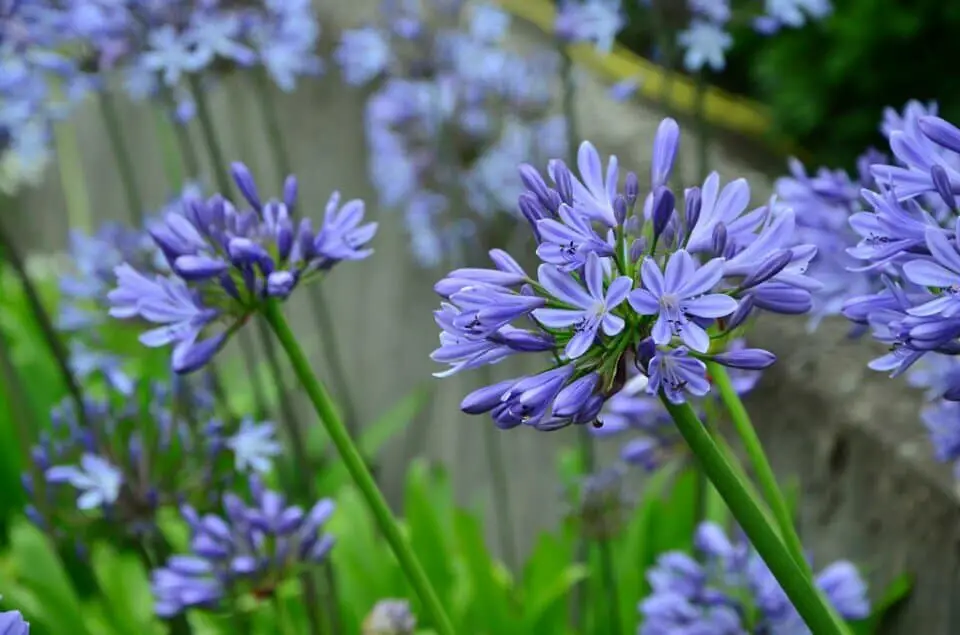Some links in the post are affiliate links and I get a commission from purchases made through some links found in the post.
Whenever someone asks why their agapanthus is yet to flower, the most common response is that their plant needs more light. It’s what I would ask someone if they shared such a concern with me.
Is your agapanthus getting enough sun? Where have you placed it in your garden? Could you consider moving it? More often than not, you find that the plant is not producing blooms because of that simple reason.
Interestingly, the agapanthus does not have constant light needs – these change per the season and the climate. The agapanthus does well in full sun in the summer, and in the other months, it prefers staying cool.
You must understand when to move it and why, which I have detailed in this guide.
I have also included signs that your plant needs more light exposure and what you can do about it. Come next season, you are sure to enjoy a bountiful array of blooms:
What Type of Light Does My Agapanthus Need?
 Earlier, I stated that the kind of light the agapanthus needs changes over the seasons. Let me explain why this is the case.
Earlier, I stated that the kind of light the agapanthus needs changes over the seasons. Let me explain why this is the case.
The agapanthus is a flowering plant, and like many such species, it uses its food for two main activities – producing foliage and flowering.
It needs water, nutrients, and light to make this food, using a process known as photosynthesis. And the energy to keep the process going comes from the photons present in the light.
Thus, when it is actively flowering, it needs more photons and thus more sun exposure. But in the winter, this exposure is not as necessary as the plant will be in its dormant stage.
The light types you need to consider for your plant are:
1) Full Sun
This light exposure is also known as bright and direct light, and it comes straight from the sun, unbarred. It has the highest number of photons and generally equates to at least 6 hours of light exposure per day.
2) Partial Shade
This exposure refers to full sun exposure for at least 4 hours a day. It is different from partial sun as the latter refers to exposure to afternoon sun.
Instead, this kind of exposure requires exposure to the morning sun which is gentle to the plant and still has enough photons to trigger photosynthesis. This light is also sometimes referred to as filtered light or dappled light.
3) Bright and Indirect Light
People growing their plants indoors can consider this type of light akin to partial shade.
It also refers to exposure to the sun for a few hours a day, preferably in the morning. And shielding the agapanthus from the afternoon sun.
When the plant is actively flowering during the spring and summer, full sun is the best option.
However, if you live in a hot region, you can move the plant to partial shade to prevent sunburn. In the fall, partial shade should be good enough. And in the winter, lower light exposure would be okay.
You may also like: 5 great planting combinations with your agapanthus
How Much Light Does an Agapanthus Need?
The lighting needs will depend on the season and your climate. You can grow the agapanthus in USDA zones 8 to 10 under the following exposure:
- In lower USDA zones: You can place the agapanthus in full sun, ensuring it gets at least 6 hours of sunlight a day. That will give it the energy it needs to keep making food which can fuel flower production.
- In higher USDA zones: You can still leave the plant in the full sun. However, you would need to limit the number of hours to about 3-4, which you can achieve by placing the plant near shade. Or you can work with partial shade/ bright and indirect light, allowing the plant to be in such light for at least 4 hours a day.
That’s the long and short of its light needs. How can you know that you are not giving your plant its ideal light requirements? Read on for more.
What Happens If Your Agapanthus Gets Too Little Light?
The agapanthus is native to Africa, where the temperatures are quite high, hence its ability to grow in USDA zones 8 to 10.
So, you can imagine that it would not be too happy with being kept in low light conditions. If you do not give it at least 4 hours of access to bright and indirect light/ partial shade, the plant will show the following signs:
Not Flowering
The agapanthus, also known as the blue African lily, is a flowering plant. And when it has light, water, and nutrients, it produces blue flowers that last from the spring to the summer for reblooming plants.
Some plants even bloom towards the start of fall. So, if you notice that your agapanthus has not produced flowers yet has access to water and nutrients, you will know that light is the likely issue.
You should try moving it to a sunnier spot towards the start of spring to trigger the flowering process.
Elongated Growth
The agapanthus generally grows about 9 to 30 inches tall. But this growth is strong and stable, allowing the plant to stand tall even in the wake of heavy drafts like those in the winter.
So, what happens when the plant has poor access to light? It compensates. It tries to grow taller to reach more light and thus develops weak stems which look abnormally tall and leggy.
Please note that the taller it grows, the weaker it becomes, and you cannot reverse this kind of growth. To give the plant a better chance of growth, you can move it to a spot with more access to the sun.
Poor Growth Rate
 Your agapanthus can stop growing entirely or take up a slowed pace. This change results from the lack of energy that the plant derives from food.
Your agapanthus can stop growing entirely or take up a slowed pace. This change results from the lack of energy that the plant derives from food.
After all, if it cannot get enough photons to start photosynthesis, it must give up some plant activities and instead focus on staying alive.
You will notice that the plant produces weak and small leaves, which cannot make as much food as the usual leaves. It shows that the plant is struggling.
Leaning Growth
This sign is quite similar to elongated growth. But instead of growing straight, the stem takes on an angle headed towards the light.
The plant does this to reach the light source to make enough food to sustain its growth. Please note that this can also show in an agapanthus growing indoors that is not rotated often.
Your plant may be in a sunny spot, but since only one side receives direct light, the other side appears weak and has fewer and smaller leaves. That’s the side likely to lean towards the window or any other light source in the area.
Overwatering
Often, overwatering results from giving your plant water even when its soil is saturated. But sometimes, you might be waiting for the soil to dry out, yet when you feed the plant, the soil appears soggy.
When a plant does not have access to enough light, it cannot make enough food and thus does not use much of the water in its soil.
So, most of it remains around the roots and makes it harder for them to breathe, thus creating suitable conditions for root rot.
The best thing is to move the agapanthus to a sunnier spot and check if the plant starts using water faster. If not, you may need to assess the potting mix, drainage holes, and other factors that could be to blame.
Chlorosis
Often, a lack of chlorophyll results from a lack of essential minerals like iron and nitrogen. But even in the presence of these minerals, your plant may still lack chlorophyll. Why?
Chlorophyll develops in plant parts that have access to light. So, when the light exposure suffers a dip, so does the production of this pigment which is essential to photosynthesis.
If you do not move the agapanthus, the leaves eventually yellow and die, further preventing the plant from making food.
If you do not act upon noticing such signs, your plant can eventually die. Yes, access to light is that important.
What Happens If Your Agapanthus Gets Too Much Light?
While the agapanthus enjoys sun exposure, it has a limit. For example, placing it in the full sun in higher USDA zones can result in the following issues:
Sunburn
 When the surrounding temperatures are unbearably high, cell breakdown occurs in the agapanthus, affecting its leaves, stem, and flowers.
When the surrounding temperatures are unbearably high, cell breakdown occurs in the agapanthus, affecting its leaves, stem, and flowers.
This damage paves the way for the plant’s dehydration and could kill it. You can tell that the plant has suffered sunburn when its leaves start yellowing and curling.
They eventually brown and fall off even before reaching their mature phases. Please note that continued sunburn can kill the plant.
High Plant Temperatures
The agapanthus may feel hot to the touch, signalling that it’s unable to radiate the heat back to the environment and is thus sweltering in it.
Over time, this can lead to more issues, and you need to move the plant to a cooler location.
Drooping
When your agapanthus absorbs water similarly to its transpiration and evaporation, it remains firm.
But when the water loss exceeds the water uptake due to extreme temperatures, the plant’s leaves start drooping to reduce the exposed surface area. You may thus notice that the plant seems to have wilted.
The soil will also dry out faster, even if you use the right potting mix. You may also notice brown patches and fading on the plant’s leaves, which are indicative of heat stress.
Where To Place Your Agapanthus to Get The Best Light
The agapanthus loves being in the sun. However, this level of exposure can prove to be too much in the higher USDA zones.
Moreover, the afternoon sun rays are much harsher and can cause sunburn in the plant. Thus, you can protect your plant by positioning it as follows:
Outdoors
- Towards the east of the garden, if you live in a hot area: This spot receives partial shade as it only gets morning sun and remains shielded from the afternoon sun. Even when temperatures soar in the summer, the plant will remain shielded from the harsh rays.
- Towards the south of the garden if you live in a cool area and are in the northern hemisphere/ the north of the garden if you live in a cool area and are in the southern hemisphere: These spots receive full sun, which is ideal in the spring. However, you may need to shade the plant partially in the summer when the temperatures rise.
Indoors
- Towards an east-facing window where it can get morning sun, or
- Towards a south-facing window if you live in the northern hemisphere/ a north-facing window if you live in the southern hemisphere. In the summer, the temperatures might get a little out of hand, but you can always locate the plant in a cooler spot.
Please note that you must rotate the plant’s pot every week to avoid leggy and leaning growth.
Will Agapanthus Grow in The Shade?
Shade falls into two levels: partial shade and full shade. Full shade is too much for the agapanthus as it implies receiving up to 4 hours of light a day.
The energy gained from such exposure would not be enough to sustain flowering.
The best type of shade is the partial shade which allows the plant to receive at least 4 hours of morning sun while shielding it from the harsh afternoon sun.
Can Agapanthus Grow in Artificial Light?
Did you know you can grow the agapanthus indoors? Many people do, which allows them to control the conditions under which their agapanthus plants grow.
And luckily, that also includes supplementing natural light with artificial light. Artificial light works like sunlight and contains the wavelengths needed to support foliage and flower development.
How To Grow an Agapanthus Using an Artificial Light
The first step is to choose the right kind of light between:
- Fluorescent lights: These have low heat emission and come in many sizes,
- LEDs: These are the most energy-efficient, have a wide range of spectrums, emit low heat, and are quite long-lasting,
- Incandescent lights: These have high heat emission and rank lower than the two above, and
- Halogen lights: These full-spectrum lights have a high heat emission and are thus not the best.
While metal halide lights are also an option, they are not the best for flowering species like the agapanthus.
What’s the second step? You need to mount the light above the agapanthus, leaving at least 10 inches between the light and the plant.
Then leave the light on for 6 hours and see how the plant responds. You can then increase or reduce the exposure accordingly.
Final Thoughts
 Getting the hang of all the light terms can be a bit challenging. But all you need to remember is that your plant needs partial shade if you live in a hot climate and full sun if you live in a cool climate.
Getting the hang of all the light terms can be a bit challenging. But all you need to remember is that your plant needs partial shade if you live in a hot climate and full sun if you live in a cool climate.
And if you get it wrong, the plant will always show signs of distress, allowing you to rectify the error.
Happy Gardening!

